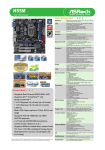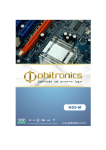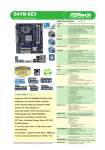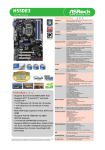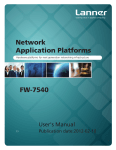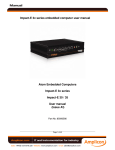Download User Manual
Transcript
Embedded & Industrial Computing Hardware Platforms for Embedded and Industrial Computing LEC-7106 V1.0 >> User's Manual Publication date:2014-05-29 About About Overview Acknowledgement Icon Descriptions The icons are used in the manual to serve as an indication of interest topics or important messages. Below is a description of these icons: NOTE: This check mark indicates that there is a note of interest and is something that you should pay special attention to while using the product. WARNING: This exclamation point indicates that there is a caution or warning and it is something that could damage your property or product. Intel, Pentium and Celeron are registered trademarks of Intel Corp. Microsoft Windows and MS-DOS are registered trademarks of Microsoft Corp. All other product names or trademarks are properties of their respective owners. Compliances CE This product has passed the CE test for environmental specifications. Test conditions for passing included the equipment being operated within an industrial enclosure. In order to protect the product from being damaged by ESD (Electrostatic Discharge) and EMI leakage, we strongly recommend the use of CE-compliant industrial enclosure products. FCC Class A Online Resources The listed websites are links to the on-line product information and technical support. Resource Website Lanner http://www.lannerinc.com Product Resources h t t p : / / w w w. l a n n e r i n c. co m / download-center/ RMA http://eRMA.lannerinc.com This equipment has been tested and found to comply with the limits for a Class A digital device, pursuant to Part 15 of the FCC Rules. These limits are designed to provide reasonable protection against harmful interference when the equipment is operated in a commercial environment. This equipment generates, uses and can radiate radio frequency energy and, if not installed and used in accordance with the instruction manual, may cause harmful interference to radio communications. Operation of this equipment in a residential area is likely to cause harmful interference in which case the user will be required to correct the interference at his own expense. Copyright and Trademarks This document is copyrighted, © 2014 All rights are reserved. The original manufacturer reserves the right to make improvements to the products described in this manual at any time without notice. No part of this manual may be reproduced, copied, translated or transmitted in any form or by any means without the prior written permission of the original manufacturer. Information provided in this manual is intended to be accurate and reliable. However, the original manufacturer assumes no responsibility for its use, nor for any infringements upon the rights of third parties that may result from such use. Embedded and Industrial Computing 2 TTaTTable of Contentsbeable of Conte Chapter 1: Introduction 4 System Specification . . . . . . . . . . . . . . . . . . . . . . . . . . . . . . . . . . . . . . . . . . . . 4 Package Contents . . . . . . . . . . . . . . . . . . . . . . . . . . . . . . . . . . . . . . . . . . . . . . 5 Optional Accessories . . . . . . . . . . . . . . . . . . . . . . . . . . . . . . . . . . . . . . . . . . . . 5 Chapter 2: System Components 6 System Drawing . . . . . . . . . . . . . . . . . . . . . . . . . . . . . . . . . . . . . . . . . . . . . . . 6 Block Diagram . . . . . . . . . . . . . . . . . . . . . . . . . . . . . . . . . . . . . . . . . . . . . . . . 7 Front Components . . . . . . . . . . . . . . . . . . . . . . . . . . . . . . . . . . . . . . . . . . . . . 8 Rear Components . . . . . . . . . . . . . . . . . . . . . . . . . . . . . . . . . . . . . . . . . . . . . . 9 Chapter 3: Board Layout 10 External Connectors . . . . . . . . . . . . . . . . . . . . . . . . . . . . . . . . . . . . . . . . . . . 10 Internal Connectors and Jumpers . . . . . . . . . . . . . . . . . . . . . . . . . . . . . . . . . . . 11 Connectors and Jumpers List . . . . . . . . . . . . . . . . . . . . . . . . . . . . . . . . . . . . . 12 Jumper Settings . . . . . . . . . . . . . . . . . . . . . . . . . . . . . . . . . . . . . . . . . . . . . . 13 Chapter 4: Hardware Setup 16 Preparing the Hardware Installation . . . . . . . . . . . . . . . . . . . . . . . . . . . . . . . . . 16 Installing the System Memory . . . . . . . . . . . . . . . . . . . . . . . . . . . . . . . . . . . . . 16 Installing the Hard Disk . . . . . . . . . . . . . . . . . . . . . . . . . . . . . . . . . . . . . . . . . 17 Installing the 3G SIM Card . . . . . . . . . . . . . . . . . . . . . . . . . . . . . . . . . . . . . . . 17 Installing the Wireless 3G Module . . . . . . . . . . . . . . . . . . . . . . . . . . . . . . . . . . . 17 Appendix A: Programming Watchdog Timer 18 Appendix B: Terms and Conditions 20 Warranty Policy . . . . . . . . . . . . . . . . . . . . . . . . . . . . . . . . . . . . . . . . . . . 20 RMA Service . . . . . . . . . . . . . . . . . . . . . . . . . . . . . . . . . . . . . . . . . . . . . 20 3 Chapter 1 Chapter 1: Introduction Thank you for choosing the LEC-7106. The LEC-7106 features Intel Atom D525(dual core) and ICH8M chipset. It features a LAN port and a VGA port as well as audio ports (microphone-in/line-out). The system also features extra serial communication ports (a total of 4 COM ports) for a variety of industrial communications and applications. The following highlights the functionalities of the LEC7106 system: Introduction System Specification Processor Options Intel® Atom™ D525 (1.8 GHz) CPU Chipset Intel® ICH8M BIOS System Memory •• One 10/100/1000 Mbps LAN •• Six USB 2.0 ports (four via external type A ports and two via internal pin headers) •• SATA HDD support Digital I/O N/A Expansion Bus Mini-PCIe x 1: one with SIM card reader and USB 2.0 Signal OS Support Microsoft Window 7/7 Embedded, Windows XP Pro/XP Embedded, Linux Cent OS 5 Storage Networking •• Featuring power switch through Phoenix contact for distant power on/off control •• One Mini-PCIe connector (comes with a SIM card reader) to support 3G/GPS Internet connection DDR3 SDRAM 800MHz 4x External TypeA USB 2.0, 2x Internal USB ports •• Audio input and output through Mic-in and Line-out jack Technology USB •• A total of 4 serial RS-232 ports supporting automatic hardware flow Control 1 x 204-pin SO-DIMM socket Max. Capacity Up to 4 GB •• A VGA port powered by Intel Integrated Graphics Media Accelerator 3150 AMI 16bit SPI UEFI BIOS Sockets Display HDD/SSD Support Expansion 1 x 10/100/1000 Mbps, Autosensing,RJ-45 Controller Graphics Controller Display Interface Intel i210AT x 1 Intel® integrated Graphics Media Accelerator 3150 Weight Physical Characteristics Dimensions (WxHxD) Mounting Options Operation Temperature Standard and Regulation Reliability Storage Temperature Ambient Relative Humidity (non-condensing) Input Voltage Power Consumption Connector Aluminum 1 kg 268 x 44 x 174 mm (10.55” x 1.73” x 6.85”) Rack, VESA, DIN-rail and Wall mount -10~55°C (with Industrial grade components), -5~45°C (with Commercial grade components) -20~75°C 5 to 95% (non-condensing) +12 V DC TBD DC jack with lock AC Adapter 60W +12V @5A EMC CE/FCC Green product RoHS Built-in buzzer and RTC (real-time clock) with Alter tool battery lithium backup Automatic Watchdog Timer 1~255 level time interval Reboot Trigger system reset, software programmable MTBF Embedded and Industrial Computing VGA x 1 (up to 2048x1536) Power, HDD active, 3G active Housing Power 1 x CF socket Type I/II, 2x SATA ports LAN LEDs Environment 1 x 2.5” HDD/SSD drive bay TBD 4 Chapter 1 Introduction Package Contents Your package contains the following items: •• LEC-7106 Fanless Embedded System •• Serial-ATA Data Cable (P/N:080W1N0002001) •• 2-pin Female Terminal Block (P/N: 04AW20023Z101) •• Mini-PCIe module screws (P/N: 070W101000401) •• Drivers and User’s Manual CD (P/N: S09OADA19H100) Optional Accessories The system has a variety of optional accessories including the power cords and Wi-Fi or 3G modules for extended capabilities. For details of these modules, visit: http://www.lannerinc.com/products/all-purpose-boxcomputers/industrial-automation/lec-7106 Embedded and Industrial Computing 5 Chapter 2 System Components Chapter 2: System Components System Drawing Mechanical dimensions of the LEC-7106 Unit: mm 2 3 4 5 6 7 8 9 10 11 12 13 14 15 17 16 18 19 20 21 22 23 24 A B C D E F G 282.5 100 282.5 44 100 44 H 7 7 14 14 I R1 .7 5 12.5 12.5 R1.7 5 92 92 100 100 174 174 R1.75 J 12.5 12.5 R2 14 14 R4 K R2 L M 1 MARK TOL RANGE 2 3 4 5 6 7 8 9 NCT X X X X DIE MOLD Extrusion USER 0~10 0.15 0.10 0.10 0.10 XXX 10~50 0.20 0.15 0.15 0.15 XXX 50~100 0.25 0.20 0.20 0.20 XXX 100~300 0.30 0.20 0.25 0.20 XXX 300~600 0.35 0.25 0.30 0.25 XXX 600~1200 0.40 0.30 0.35 0.30 XXX 1 1 1 1 ANG TOL 1 APPROVED EXAMINED DESIGNED REV DESCRIPTION LEC-7106 PART NO MATERIAL UNIT SCALE THICKNESS mm 1:1 COATING CLASSIFICATION SIZE SHEET A0 1/1 PAINTING DATE MODEL PART NAME Lanner 85 2 PERSPECTIVE FILE NAME VERSION 0-ASM-SYSTEM-LEC-7106-V01 0.0 DATE 25-Mar-14 1) 6 Embedded and Industrial Computing Chapter 2 System Components Block Diagram The block diagram depicts the relationships among the interfaces and modules on the motherboard.. Processor VGA DDR3 800/1066 1x SO-DIMM Intel D525 (BGA) DMI2 x4 1x 2.5" HDD/SSD SATA Connector 2x SATA connectors Mini-PCIe Socket with SIM card Reader 1x PCIe SATA II PCIe USB 2.0 Intel i210AT PCH ICH8-M MIC/Line-in Jack HD Audio VIA VT1718S GbE Controller SPI USB LAN1 RJ-45 Flash BIOS USB 2.0 Type A x 4 Pin header x 2 HD LPC Serial Port 4x DB-9 for RS-232 H/W Monitor WDT Winbond W83627UHG PS/2 Connector Keyboard/Mouse 7 Embedded and Industrial Computing Chapter 2 System Components Front Components F1 F2 F3 Component F1 Keyboard and Mouse Connector F2 MIC IN/LINE OUT F3 Serial Ports COM1~ COM4 F4 Power-on Switch Description PS/2 keyboard and mouse connector F4 F5 F6 Pin Definition Reference KB1, MS1 on page 14 An USB type A connector. MIC1, LIN1 on page 13 Serial ports through the DB-9 connector. COM1~COM4 on These ports support RS-232 communication. page 13 A power-on switch through the Phoenix J12 on page 15 contact for distant power-on/off control F5 Power Led (Green) and HDD HDD (Yellow) • Blinking: data access activities • Off: no data access activities Status A programmable dual green/orange LED which can be used for indicating system status. Power • F6 Power Button with dual LED On: The computer is on. • Off: The computer is off . ATX Power-on button with LEDs: Standby mode in Red; Power-on mode in Green 8 Embedded and Industrial Computing Chapter 2 System Components Rear Components R1 Component R3 Description R1 VGA Port R2 Four USB 2.0 Ports R3 10/100/1000Mbps LAN ports speed R2 LINK/ACT R4 R5 R6 Pin Definition Reference The displays can support VGA up to 2048x1536 VGA1 on page 14 resolution. An USB type A connector. In additional to these USB1, USB2 on Page 15 two ports, there are also 2 ports via internal pin headers. One RJ-45 (network) jack with LED indicators as described below. The LAN port is provided by Intel i210AT. The i210AT supports PXE remote boot. LINK/ACT (Yellow) • On/Flashing: The port is linking and active in data transmission. • Off: The port is not linking. SPEED (Green/Amber) • Amber: The connection speed is 1000Mbps. • Green: The connection speed is 100Mbps • Off: The connection speed is 10Mbps. R4 Antenna Hole Reserved for Antenna holes. R5 DC-In (power) Connector DC +12V Power-in Connector. The LEC-7106 system supports screw-locked power plug which allows secure power connection. R6 Reset Reset switch RST1 on page 15 9 Embedded and Industrial Computing Chapter 3 Board Layout Chapter 3: Board Layout External Connectors The following picture highlights the location of the external ports. Refer to the table 3.1 Connector List for more details. LAN1 KB1 MS1 MIC1 LIN1 USB2 COM4 USB1 VGA1 COM3 COM2 COM1 J12 LEB-7106 Embedded and Industrial Computing 10 Chapter 3 Board Layout Internal Connectors and Jumpers The following picture highlights the location of internal connectors and jumpers. Refer to the table 3.1 Connector List for more details. PSATA1 SATA1 MPCIE1 USB3 JSPI1 SC3T1 SC4T1 CN9 SC2T1 LPC1 SC1T1 CMOS1 LEB-7106 Embedded and Industrial Computing 11 Chapter 3 Board Layout Connectors and Jumpers List The tables below list the function of each of the board jumpers and connectors by labels shown in the above section. The next section in this chapter gives pin definitions and instructions on setting jumpers. Table 3.1 Connector List for the Main Board Labels Function COM1~COM4 CMOS1 CN9 J12 JSPI1 KB1 LIN1 LPC1 MIC1 MPCIE1 MS1 PW1 RST1 SATA1/PSATA1 SC1T1/SC2T1/SC3T1/SC4T1 USB1/USB2 USB3 VGA1 RS-232 COM Ports Clear CMOS Jumper SIM Card Reader Power Switch with Phoenix Contact Connector Serial Peripheral Interface Keyboard/Mouse Connector Line-Out Audio Jack Low-pin Cound Connector Mic-in Audio Jack Mini-PCIe Connector PS/2 Mouse Connector SATA Power Reset Button Serial-ATA Connector COM1/COM2/COM3/COM4 Pin 9 Function Selection Dual USB Ports USB Pin Header VGA Connector Embedded and Industrial Computing Pin Definition Reference Page P13 P14 P15 P15 Reserved for factory use P14 P13 Reserved for factory use P13 P15 P14 P14 P15 P14 P13 P15 P15 P14 12 Chapter 3 Board Layout Jumper Settings SC1T1/SC2T1/SC3T1/SC4T1: Select COM1/COM2/ COM3/COM4 Pin 9 (ring indicator) signal The Main Board Microphone-in Audio Jack (MIC1) Pin No. 1 3 5 Signal GND_AUD GND_AUD MIC_OUT_R Pin No. 2 4 Signal MIC_OUT_L GND_AUD Pin No. 2 4 Signal FRONT_OUT_L GND_AUD 1 3 5 2 4 6 Line-out Audio Port (LIN1) Pin No. 1 3 5 Signal GND_AUD GND_AUD FRONT_OUT_R Switch Combination Protocol +5V +12V RI (default) SW1/SW4 1-2 3-4 5-6 RS-232 Serial Port (COM1~COM4): It is an RS-232 port through the D-SUB9 connector. 12345 6789 Pin No. 1 2 3 4 5 6 7 8 9 Signal RS-232 DCD RxD TxD DTR GND DSR RTS CTS RI (ring indicator) Embedded and Industrial Computing 13 Chapter 3 Board Layout PS/2 Keyboard Connector (KB1) VGA (VGA1) 54321 Pin No. 1 3 5 Signal KDAT_R GND KCLK_R Pin No. 2 4 6 Signal N/A VCC5_KB N/A PS/2 Mouse Connector (MS1) 15 14 13 12 11 Pin 1 2 Pin No. 1 3 5 Signal MDAT_R GND MCLK_R Pin No. 2 4 6 Signal N/A VCC5_KB N/A 3 4 5 Signal Red Color Signal Green Color Signal Blue Color Signal N/A CRT_ON Pin 6 Signal GND Pin 11 Signal N/A 7 GND 12 DDC DAT 8 GND 13 HSYNC 9 10 VCC5 GND 14 15 VSYNC DDC CLK Clear CMOS jumper (CMOS1): It is for clearing the CMOS settings. Serial-ATA Connector (SATA1/PSATA1): It is for connecting a 2.5’’ harddisk to serve as your system’s storage. It can support SATA II which features Data transfer rates up to 3.0 Gb/s (300 MB/s). Note that PSATA1 has power on pin 7 to support eSATA connector. 1 2 3 4 5 6 7 1 2 3 4 5 6 7 SATA1 Pin No. 1 2 3 4 5 6 7 Function GND TX0_P TX0_N GND RX0_N RX0_P GND PSATA1 Pin No. 1 2 3 4 5 6 7 Function GND TX0_P TX0_N GND RX0_N RX0_P VCC5_ SATADOM 4-pin Serial-ATA Power Connector (PW1): connecting the SATA power cord. 4 3 2 1 Pin No. 1 2 3 4 3 2 1 Pin No. 1-2 2-3 Pin Name Normal (Default) Clear CMOS It is for Function VCC12_PS GND GND VCC_HDD Embedded and Industrial Computing 14 Chapter 3 Board Layout Dual USB Port Connector #0 and #1 (USB1): Dual USB Port Connector #2 and #3 (USB2) Pin No. 1 2 3 4 5 5 6 7 8 1 2 3 4 6 7 8 Pin Name USB1_VCC5 USB1N/3N USB1P/3P GND USB0_VCC5/ USB2_VCC5 USB0N/USB2N USB0P/USB2P GND Pin No. 1 2 3 4 5 6 7 8 9 10 Pin Name USB4_VCC5 GND N/A USB5P USB4N USB5N USB4P N/A GND N/A USB Pin Header (USB3) 10 9 8 7 6 5 4 3 2 1 Reset Button (RST1) 1 3 2 4 Mini PCI Express Connector (for 3G/GPS card with USB signal, MPCIE1): PIN 1 3 5 7 9 Pin Name WAKE# N/A N/A CLKREQ# GND PIN 2 4 6 8 10 Pin Name VCC3.3 GND VCC1.5 VREG_USIM UIM_DATA 11 CLK_PCIE_MINI_ N1 CLK_PCIE_MINI_P1 GND RSV RSV GND PCIE_RX_N2 PCIE_RX_P2 GND GND PCIE_TX_N2 PCIE_TX_P2 GND GND VCC3.3 VCC3.3 GND RSV RSV RSV RSV 12 UIM_CLK 14 16 18 20 22 24 26 28 30 32 34 36 38 40 42 44 46 48 50 52 UIM_RESET UIM_VPP GND RF_KILL_N1 PLTRST PCIE1_P24 GND VCC1.5 SMBCLK SMBDATA GND USB_N6 USB_P6 GND LED1_WWAN LED1_WLAN LED1_WPAN VCC1.5 GND VCC3.3 13 15 17 19 21 23 25 27 29 31 33 35 37 39 41 43 45 47 49 51 SIM Card Reader (CN9) Pin NO. 1 2 3 4 Description RST_BTN GND GND N/A Power-on Switch through Phoenix Contact (J12): A Phoenix connector for distant power switch. C5 C1 C7 C3 Pin NO. C1 C2 C3 Signal UIM_PWR UIM_RST# UIM_CLK Pin NO. C5 C6 C7 Signal GND UIM_VPP UIM_DATA 21 Pin No. Pin Name 1 PWR_BTN_N 2 VCC5_SB Embedded and Industrial Computing 15 Chapter 4 Chapter 4: Hardware Setup Hardware Setup Note: The motherboard can support up to 4 GB memory capacity in maximum. Preparing the Hardware Installation To access some components and perform certain service procedures, you must perform the following procedures first. WARNING: To reduce the risk of personal injury, electric shock, or damage to the equipment, remove the power cord to remove power from the server. The front panel Power On/Standby button does not completely shut off system power. Portions of the power supply and some internal circuitry remain active until AC power is removed. 1. Unpower the LEC-7106 and remove the power cord. 2. Take off the 3 screws from the two sides of the LEC7106 System. 3. Open the cover. Installing the System Memory The motherboard supports DDR3 memory to meet the higher bandwidth requirement of the latest operating system and Internet applications. It comes with one double data rate type three (DDR3) small outline dual inline memory module (SO-DIMM) socket. Embedded and Industrial Computing 16 Chapter 4 Hardware Setup Installing the Hard Disk Installing the 3G SIM Card The system can accommodate one Serial-ATA disk. Follow these steps to install a hard disk into the LEC-7106: 1. Unlock the SIM card reader by sliding it outward and flip it up diagonally. 1. Place hard disk alongside of the mounting bracket and align the holes of the hard disk with the mounting holes of the bracket 2. The angled corner of the SIM ensures that the card fits only the correct way in the tray. Make sure that the ICs will be in contact with the bottom of the reader. 2. Attach the hard disk to the bracket with 4 mounting screws. 3. Insert the SIM card into the reader diagonally. Close and lock the reader. You should feel a click when the SIM card is locked securely in the reader. 3. Connect the Serial-ATA power and data cables to the hard disk’s connectors. 4. Attach the hard disk with the bracket back to the system. 5. Plug the Serial-ATA cables (power and data) to the Serial-ATA Connectors on the main board. 1 Installing the Wireless 3G Module 1. Align the wireless module’s key with the Mini-PCIe slot notch. 2. Insert the wireless module into the connector diagonally. 3. Attach the wireless module to the slot with the screws (Use the Mini-PCIe module screws contained within the package). Installing SIM Card 2 lock Unlock Installing 3G and Wi-Fi module on the PCIe socket 3 Embedded and Industrial Computing 17 Appendix A Appendix A: Programming Watchdog Timer A watchdog timer is a piece of hardware that can be used to automatically detect system anomalies and reset the processor in case there are any problems. Generally speaking, a watchdog timer is based on a counter that counts down from an initial value to zero. The software selects the counter’s initial value and periodically restarts it. Should the counter reach zero before the software restarts it, the software is presumed to be malfunctioning and the processor’s reset signal is asserted. Thus, the processor will be restarted as if a human operator had cycled the power. Programming Watchdog Timer 1. Click the Setup program. 2. The welcome screen appears. Click Next to proceed. For sample watchdog code, see Watch dog and DIO folder in the Driver and Manual CD Driver Installation Before you could access or control the operation of the watchdog and Digital I/O functions, install the the L_IO driver which is the library and driver needed for Lanner General Purpose Input/Output interface or functions. 3. The installation process proceeds. Click Close when the process completes. To install the L_IO driver: 1. Restart the computer, and then log on with Administrator privilege. 2. Insert the Drivers and User’s Manual CD to the USBoptical drive. 3. Browse the contents of the support CD to locate the file LannerIO v101.rar under the \WD_DIO\ folder and unzip the file. 4. Click the Setup program in the unzipped folder. Embedded and Industrial Computing 18 Appendix A To verify the GPIO driver installation, do the following steps: 1. Right-click on the My Computer icon, and then select Properties form the menu. 2. Click the Hardware tab, then click the Device Manager button. Programming Watchdog Timer Sample Program Via the Demo Program Enter the number of seconds to start count down before the system can be reset. Press start to start the counter and stop to stop the counter. 3. Select View from the menu and select show hidden devices . 4. The Lanner common GPIO driver should be listed under the Non-Plug and Play Drivers. If not, click the San for hardware changes button from the tool bar. Via the Command Line Execute the executable file in the program folder, then enter the values from 1~255. The system will reboot automatically according to the time-out you set. wd_tst --swt xxx (Set Watchdog Timer 1-255 seconds) wd_tst[*] --start (Start Watchdog Timer) wd_tst --stop (Stop Watchdog Timer) Embedded and Industrial Computing 19 Appendix B Appendix B: Terms and Conditions Warranty Policy 1. All products are under warranty against defects in materials and workmanship for a period of one year from the date of purchase. Terms and Conditions RMA Service Requesting a RMA# 6. To obtain a RMA number, simply fill out and fax the “RMA Request Form” to your supplier. 7. The customer is required to fill out the problem code as listed. If your problem is not among the codes listed, please write the symptom description in the remarks box. 2. The buyer will bear the return freight charges for goods returned for repair within the warranty period; whereas the manufacturer will bear the after service freight charges for goods returned to the user. 8. Ship the defective unit(s) on freight prepaid terms. Use the original packing materials when possible. 3. The buyer will pay for repair (for replaced components plus service time) and transportation charges (both ways) for items after the expiration of the warranty period. Note: Customer is responsible for shipping damage(s) resulting from inadequate/loose packing of the defective unit(s). All RMA# are valid for 30 days only; RMA goods received after the effective RMA# period will be rejected. 4. If the RMA Service Request Form does not meet the stated requirement as listed on “RMA Service,” RMA goods will be returned at customer’s expense. 9. Mark the RMA# clearly on the box. 5. The following conditions are excluded from this warranty: • Improper or inadequate maintenance by the customer • Unauthorized modification, misuse, or reversed engineering of the product. • Operation outside of the environmental specifications for the product. Embedded and Industrial Computing 20 Appendix B Terms and Conditions RMA Service Request Form When requesting RMA service, please fill out the following form. this form enclosed, your RMA cannot be processed. Company: Reasons to Return: Ŀ Repair(Please include failure details) Ŀ Testing Purpose Contact Person: Phone No. Purchased Date: Fax No.: Applied Date: RMA No: Return Shipping Address: Shipping by: Ŀ Air Freight Ŀ Sea Ŀ Others:________________ Item Model Name Item Problem Code Failure Status *Problem Code: 01:D.O.A. 02: Second Time R.M.A. 03: CMOS Data Lost 04: FDC Fail 05: HDC Fail 06: Bad Slot Ŀ Express Serial Number 07: 08: 09: 10: 11: 12: BIOS Problem Keyboard Controller Fail Cache RMA Problem Memory Socket Bad Hang Up Software Out Look Damage Request Party Authorized Signature / Date Embedded and Industrial Computing Without ___ Configuration 13: 14: 15: 16: 17: 18: SCSI LPT Port PS2 LAN COM Port Watchdog Timer 19: 20: 21: 22: 23: 24: DIO Buzzer Shut Down Panel Fail CRT Fail Others (Pls specify) Confirmed By Supplier Authorized Signature / Date 21






















